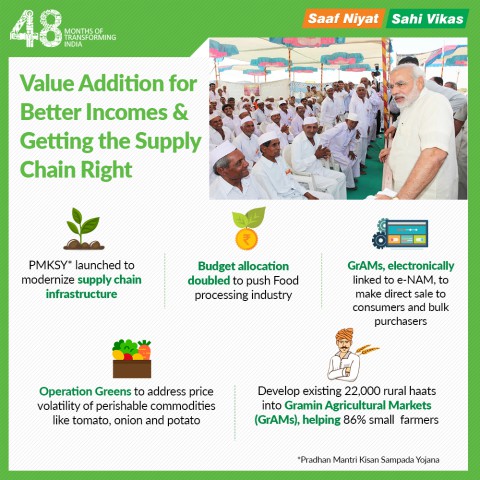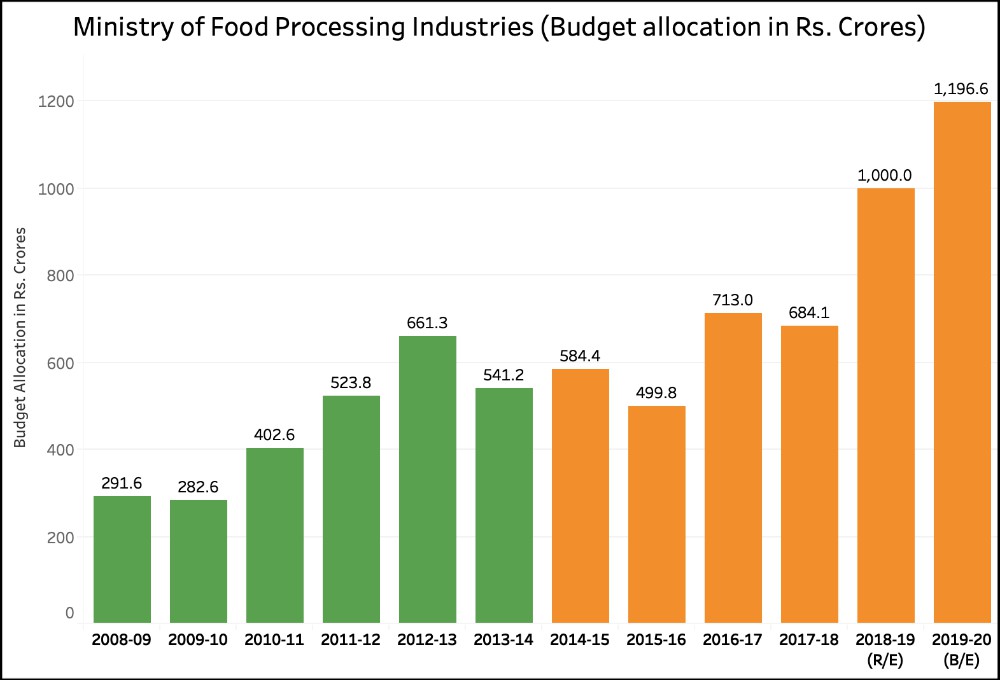[orc]The present BJP government published an infographic on the 48-months portal that makes five claims about value addition and improvement in the supply chain of the agricultural sector. This article is a fact check of these claims.
The present BJP government published an infographic on the 48-months portal that makes five claims about value addition and improvement in the supply chain of the agricultural sector. This article is a fact check of these claims.
What is the PMKSY?
The first claim is that ‘PMKSY launched to modernize supply chain infrastructure.’
PMKSY stands for the Pradhan Mantri Kisan Sampada Yojana. The website of the scheme states that ‘Government of India (GOI) has approved a new Central Sector Scheme – Pradhan Mantri Kisan SAMPADA Yojana (Scheme for Agro-Marine Processing and Development of Agro-Processing Clusters) with an allocation of Rs.. 6,000 crore for the period 2016-20 coterminous with the 14th Finance Commission cycle. The scheme will be implemented by Ministry of Food Processing Industries (MoFPI). The scheme was approved in May 2017. The following schemes will be implemented under PM Kisan SAMPADA Yojana:
- Mega Food Parks
- Integrated Cold Chain and Value Addition Infrastructure
- Creation/ Expansion of Food Processing/ Preservation Capacities (Unit Scheme)
- Infrastructure for Agro-processing Clusters
- Creation of Backward and Forward Linkages
- Food Safety and Quality Assurance Infrastructure
- Human Resources and Institutions’
Another response in the Lok Sabha in January 2019 predicts that ‘PMKSY is expected to leverage investment of Rs.31,400 crore, handling of 334 lakh MT of agro-produce valuing Rs. 1.04 lakh crore, will benefit 20 lakh farmers and generate 5.3 lakh direct/ indirect employment in the country by the year 2019-20’. The progress up to March 2018 is as follows:
While the scheme itself is new and has been launched under the BJP government, it is of interest to note that under the UPA government also, ‘Ministry of Food Processing Industries provided assistance for development of integrated cold chain and preservation of infrastructure facilities from farm gate to the consumer.’ Most of the components under the PMKSY were already under implementation and have received grants and funding much before the BJP government (2006 in some cases).
Claim: PMKSY launched to modernize supply chain infrastructure.
Fact: Government of India approved a new Central Sector Scheme – PRADHAN MANTRI KISAN SAMPADA YOJANA – (PMKSY) in May 2017. Hence the claim is TRUE. However, most of the components under this umbrella scheme have been in implementation even before the BJP has come into power.
Did budget allocation for food processing industry double?
The second claim is that ‘budget allocation doubled to push food processing industry’.
The claim does not specify the years of comparison. Hence it is difficult to verify the claim. However, the actual expenditure under the Ministry of Food Processing Industries has not followed a particular trend. It has increased & decreased both during the UPA as well as the NDA. If the actual expenditure in 2014-15 is taken as the base, then the revised estimate for 2018-19 is about 70% more than the 2014-15 figure, but not exactly double.
Claim: Budget allocation doubled to push food processing industry.
Fact: The claim does not specify the years of comparison. Hence it is difficult to verify the claim. However, the actual expenditure under the Ministry of Food Processing Industries has not followed a particular trend. It has increased & decreased both during the UPA as well as the NDA. If the actual expenditure in 2014-15 is taken as the base, then the revised estimate for 2018-19 is about 70% more than the 2014-15 figure, but not exactly double. Hence the claim remains UNVERIFIED.
What are GrAMs?
The third claim is that ‘GrAMs, electronically linked to e-NAM, to make direct sale to consumers and bulk purchasers’.
A response in Lok Sabha in February 2019 stated that ‘in the Union Budget 2018-19, Government has announced upgradation and development of existing 22,000 village haats to Gramin Agriculture Market (GrAMs) through convergence of various schemes such as Mahatma Gandhi National Rural Employment Guarantee Scheme (MGNREGS) and others. The GrAMs are to be exempted from Agricultural Produce Market Committees (APMCs) regulations and linked to e-NAM. These GrAMs are intended to facilitate farmers in selling their produce to direct buyers’.
It has to be noted that the village haats were in existence from long before the BJP government came into power but their up-gradation and linking to the electronic market is an innovation.
Claim: GrAMs, electronically linked to e-NAM, to make direct sale to consumers and bulk purchasers.
Fact: GrAMs (Gramin Agriculture Markets) are an up-gradation to the existing village haats through the convergence of different government schemes. These are to be linked to the e-NAM to facilitate farmers in selling their produce directly to buyers. Hence, the claim is TRUE. However, it has to be noted that the village haats have been in existence for a long time.
What is Operation Greens?
The fourth claim is that ‘Operation Greens to address price volatility of perishable commodities like tomato, onion and potato’.
Press Information bureau published in February 2018 that ‘taking Government’s vision ahead, the Finance Minister, in Budget 2018-19, announced the launching of ‘Operation Greens’ to address price volatility of perishable commodities like potatoes, tomatoes and onions, at an outlay of Rs. 500 crores. ‘Operation Greens’, on the lines of ‘Operation Flood’, shall promote Farmer Producers Organizations (FPOs), agri-logistics, processing facilities and professional management in the sector’.
The scheme has since been launched for Tomato, Onion and Potato (TOP) value chain with a budgetary allocation of Rs. 500 crores spread over 2018-19 and 2019-20 with allocation of Rs. 200 crores and Rs. 300 crores respectively.
Claim: Operation Greens to address price volatility of perishable commodities like tomato, onion and potato.
Fact: The Finance Minister, in Budget 2018-19, announced the launching of ‘Operation Greens’ to address price volatility of perishable commodities like potatoes, tomatoes and onions. The scheme has since been launched for Tomato, Onion and Potato (TOP) value chain with a budgetary allocation of Rs. 500 crores spread over 2018-19 and 2019-20 with allocation of Rs. 200 crores and Rs. 300 crores respectively. Hence the claim is TRUE.
Are 22,000 rural haats being developed into GrAMs?
The fifth claim is that ‘existing 22,000 rural haats are being developed into Gramin Agricultural Markets (GrAMs), helping 86% small farmers’.
According to a response in the Lok Sabha, the total number of rural haats in the country is 22711, majority of which are under local institutions of Panchayati Raj of States. Details about how many small farmers are going to benefit from this scheme are not available in the public domain.
Claim: Develop existing 22,000 rural haats into Gramin Agricultural Markets (GrAMs), helping 86% small farmers.
Fact: The total number of rural haats in the country is 22711. But data/information regarding how many small farmers it will benefit, is not available in the public domain. Hence, the first part of the claim is TRUE but the second part of it remains UNVERIFIED.
This story is part of a larger series on the 4-years of the Modi government. This series has been made possible with the flash grant of the International Fact Checking Network (IFCN). Read the rest of the stories in this series here


